FAQ
In this section you will find answers to the most commonly asked questions. We will show you some common installation mistakes. We will cover all the important subjects that are not covered in the other sections.
1. Zero EMF Heating cables
We are happy to offer to your attention our new heating cables. They are using the latest technologies with two heating conductors made in a such way that they guarantee zero magnetic field. This is required according to all the standards for best healthy and ecological heating. The insulation materials and the heating conductors are designed to work with temperatures twice higher than the current working temperatures. Each cable is separately tested with 2500V power supply. This is can absolutely guarantee that there are no hidden defects in the systems.


2. Zero EMF or a regular cable?

Both kinds of cables heat the same way and the energy consumption is also equal. The difference is in the cable constructions and the application of the two cables. The regular cables are used on top of cement floors in dry premises only. They are cheap but very reliable. Zero EMF cables can be used for all kind of floors and also for wet rooms and other special applications.
3. 120V or 240V?
This is the question most people from USA and Canada ask. The energy consumption and heating is equal with the two voltages. The difference is in the current through the thermostat. With 240V the current is twice smaller than 120V which means that one 16Amps thermostat can control twice bigger heating system. So for rooms up to 150-160sq.ft. it doesn't matter what system will you use but for bigger rooms it is better to use 240V. This is only valid for heating cable systems because the carbon heating film works only at 240V.
4. Heating cable or a mat?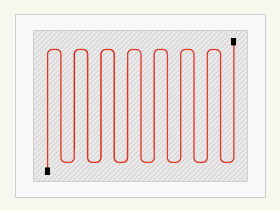

The mat is a heating cable prearranged on a mesh for easier installation. It is very easy to use mats in regular shaped rooms. If the area is irregular the time for installation with cables and with mats is pretty much the same. If you can't decide what system is better for you feel free to ask us for advice.
With the usage of the newer WiFi enabled thermostats both types can cover similar use cases. Both are easy to use and can be used in manual or automatic regime. You can choose based on your needs and aesthetic requirements.
6. What is the maximum heated area with one thermostat?
With carbon heating film the maximum heated area with one thermostat is 166sq.ft. at 220-240V. For the cable heating system if you use 120V the maximum heated area is 160sq.ft. and with 240V it is 300sq.ft.
7. How long does it take to heat up?
Heating up for the first time from a cold floor with a cable floor heating can take a few hours especially if there is no insulation underneath. After that it heats up quicker. The carbon heating film heats up very quickly. Even when started for the first time it warms the floor in 20-30 minutes.
8. How much fixing tape do you need?
Usually you can choose how much do you need according to scheme 1. So in the example scheme you will need 44ft. fixing tape which is two rolls. Each roll is 25ft. Scheme 2 shows a bigger room so here you better us 3 rolls of fixing tape – 66ft.
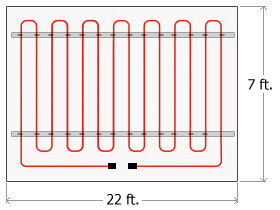
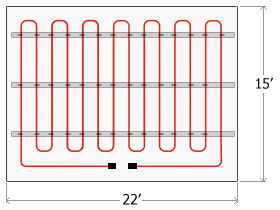
9. Heating Insulation.

Scheme 1
Scheme 2
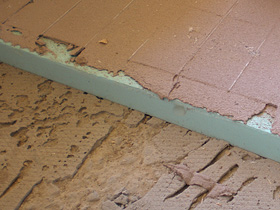
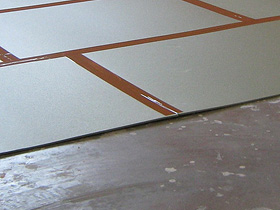
Heating Insulation under Cable floor heating
Heating Insulation under Carbon floor heating
Pay a special attention when for the floors that are outside and over cold premises. In these cases you better use a good heating insulation
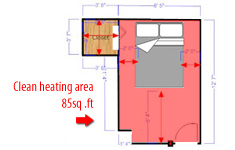 Carbon floor heating
Carbon floor heatingCalculate the clean area which will be covered with carbon film. You don't need to place it under heavy permanent furniture like wardrobes etc. At the example room there won't be carbon film under the bed and the closet. The clean area is 85sq.ft. so that's what should be filled in the form.
The carbon heating film is 20W/sq.ft. (200W/sq.m.). That's why the maximum heated area with one thermostat is 166 sq.ft. For bigger areas you need additional thermostats.
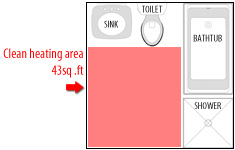 Cable floor heating
Cable floor heatingCalculate the clear area where the heating cable is placed. The clean area on the photo is 43sq.ft. – the red area.
Important: The maximum heated area for 120V is 160 sq.ft. and for 240V it is 300 sq.ft. For bigger areas you need additional thermostats.
Common problems with the heating systems installation.
11. Choosing the wrong cable.

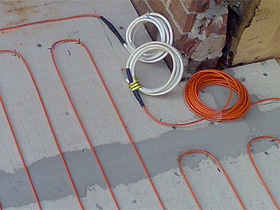
At these photos you can see a perfectly made installation but with the wrong cable. It is very important issue for smaller areas where you can't fit the extra cable. Always consult us if you are not sure what cable do you need. In these cases the customers contacted us on time and we replaced the cables with smaller ones.
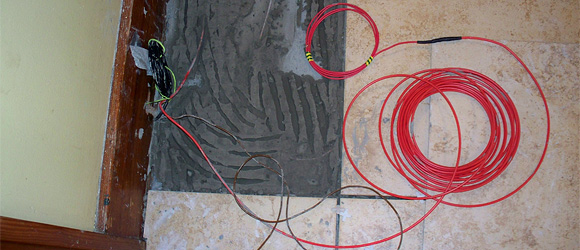 It is a one of the worst things to do. The only solution in this case is to cut the cable. We will explain how it is done but shortening the cable makes it more powerful, raises its working temperature and reduces its life.
It is a one of the worst things to do. The only solution in this case is to cut the cable. We will explain how it is done but shortening the cable makes it more powerful, raises its working temperature and reduces its life.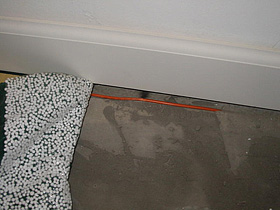
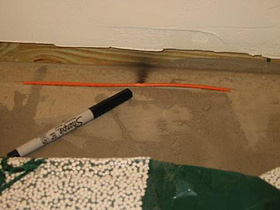
This is very bad for the cables. At the spots where the cable goes out of the cement layer it cannot evenly distribute heat and it is very likely for the cable to burn at that exact spot. This is one of the most important requirements in the Installation guide and this installation does not comply with it.
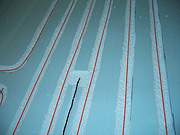
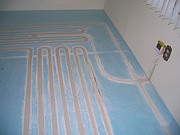
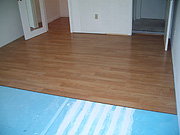
The cable is installed in grooves in the insulation materials and the locally covered with cement. There is no warranty that the cables are well covered with cement and that they will work normally. The floor sensor is installed at such location that it won't work. The heat on the laminate will not be evenly distributed and you will be able to feel it different. In this case the only solution I could offer to the customers is to move the floor sensor in the groove. The installation is working for a few years now but it is a bad experiment with mixing elements from different heating systems.



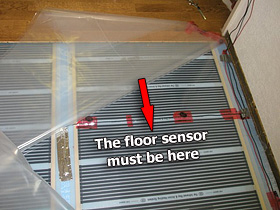 This can cause big troubles. The floor sensor placed like that doesn't do its job. With carbon heating system it is used to measure the temperature of the active part of the carbon film as explained in the installation guide.
This can cause big troubles. The floor sensor placed like that doesn't do its job. With carbon heating system it is used to measure the temperature of the active part of the carbon film as explained in the installation guide.
